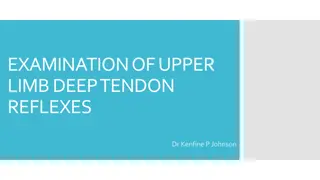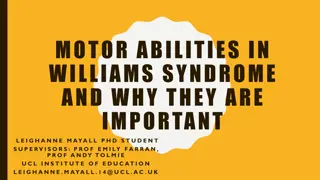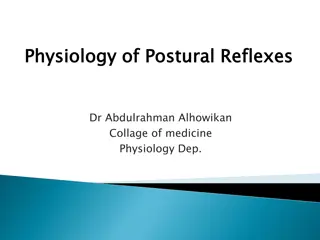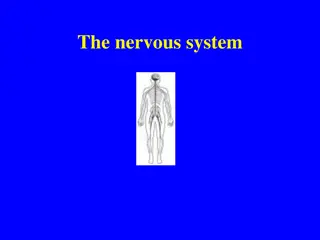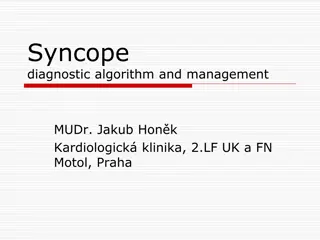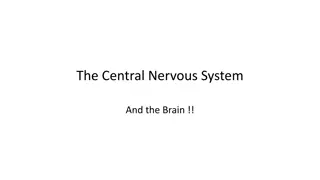Physiology of Micturition
The process of micturition (urination), the functional anatomy of the urinary bladder, neural control, the mechanism of filling and emptying of the bladder, and the neurogenic control of the micturition reflex and its disorders.
15 views • 23 slides
Understanding Spirits and Their Uses in Therapeutics and Flavoring
Spirits, also known as essences, are alcoholic or hydro-alcoholic solutions containing volatile substances. They can be classified based on therapeutic or flavoring purposes. These solutions are prepared by distillation or dissolving volatile substances in alcohol, with varying alcohol content. Spir
4 views • 17 slides
REFLEX: The Saipem Digital Knowledge Management Solution
REFLEX is a comprehensive digital knowledge management solution developed by Saipem. It focuses on leveraging experiences and lessons learned to enhance competitiveness and efficiency within the organization. The platform facilitates the validation and implementation of lessons learned through a str
7 views • 5 slides
Understanding Proprioceptors and Their Role in Body Balance
Proprioceptors play a crucial role in providing information about the position of body parts, muscle spindle response to stretch, and muscle tension regulation. Muscle spindles and Golgi tendon organs are key components in maintaining muscle tone and ensuring proper reflex actions. This article delv
1 views • 23 slides
Exploring Logical Agents and Architectures in Wumpus World
Explore the use of logical agents in the Wumpus World domain through three agent architectures: reflex agents, model-based agents, and goal-based agents. Understand how these agents operate in the challenging environment of the Wumpus World, where the task is to find the gold, return to starting pos
0 views • 21 slides
Understanding Gastric Motility and Secretion in the Stomach
This content delves into the intricate workings of the stomach, focusing on its motor functions, anatomical and physiological divisions, gastric reservoir, storage and mixing functions, and relaxation reflexes. It emphasizes the key roles of the stomach in storing and preparing food for digestion, a
0 views • 47 slides
Understanding Neonatal Reflexes in Newborn Babies
Newborn babies exhibit a range of primitive reflexes, including the Moro reflex, Glabellar Tap, Rooting and Sucking reflex, Tonic Neck reflex, Palmar and Plantar grasp reflexes. These reflexes serve as indicators for neurological development and function. Observing the presence and characteristics o
0 views • 13 slides
Understanding Upper Limb Deep Tendon Reflexes Examination
Exploring the intricacies of upper limb deep tendon reflexes (DTR) examination, this comprehensive guide elaborates on the monosynaptic stretch reflex mechanism, protective role of stretch reflexes, grading of reflexes, factors influencing reflex activity, and reinforcement techniques like the Jendr
0 views • 28 slides
Motor Abilities in Williams Syndrome and Their Importance
Motor abilities play a crucial role in the developmental journey of individuals with Williams Syndrome. From simple reflex movements to fine and gross motor skills, these abilities impact daily living, academic achievements, and overall cognitive and physical growth. Research on motor skills in both
0 views • 20 slides
Understanding Galactopoiesis and Milk Ejection in Veterinary Science
Galactopoiesis is the process of maintaining lactation in animals, involving hormones like prolactin, GH, cortisol, PTH, insulin, and oxytocin. This process also includes the role of progesterone, estrogen, and other hormones in milk production and release. Milk ejection, facilitated by oxytocin, in
0 views • 5 slides
Understanding Cough: Types, Causes, and When to Seek Medical Help
Coughing is a protective reflex action that clears the airways. It can be unproductive (dry) or productive (chesty), with various causes such as infections, allergies, and smoking. Different types of sputum indicate different conditions. Knowing when to seek medical help based on cough duration, ass
0 views • 19 slides
Understanding Cough and Common Cold
Cough is a reflex action to clear airways, often caused by viral infections. It can be productive or non-productive, acute, sub-acute, or chronic. Assessing cough duration, nature, associated symptoms, drug-induced or condition-induced factors is crucial. Non-pharmacological treatments include steam
1 views • 31 slides
Understanding Antitussive and Expectorant Medications in Pharmacology III
Cough is a vital reflex that helps clear irritants from the respiratory tract. Antitussives suppress cough reflex, with varying mechanisms of action. Different types of drugs are used in the symptomatic treatment of cough, classified based on their modes of action. Dextromethorphan and codeine are c
1 views • 7 slides
Understanding Respiratory System Pharmacology and Cough Physiology
The regulation of respiration involves sensory and efferent pathways, with afferent pathways comprising stretch receptors, C-fibres, and irritant receptors, while efferent pathways include parasympathetic and sympathetic nerves. Cough physiology is a protective reflex initiated by various stimuli to
2 views • 43 slides
Understanding Reflex Arcs and Testing Responses for Safety
Explore the reflex arcs involving organs like the eyes, hands, and feet to understand how they keep us safe. Learn about reflex responses such as pupil constriction, blinking, Hoffman response, and Babinski reflex, which help protect us from harm. Test these reflexes to assess their functionality an
0 views • 22 slides
Understanding Reflexes: A Quick Guide to How They Work
Reflexes are rapid, involuntary responses that help protect our body from harm. They bypass the brain for speedy reactions, such as pulling away from a hot surface. This guide explains the reflex arc process and why reflexes are vital for our safety.
0 views • 10 slides
Understanding Microwave Tubes and Klystron Technology
Microwave tubes play a crucial role in high-frequency applications due to their efficiency and operating principles. Conventional tubes face limitations beyond 100MHz, while efficient microwave tubes utilize electron velocity modulation for power conversion. Klystron tubes, such as Reflex Klystron,
4 views • 19 slides
Exploring the Mammalian Diving Reflex
Delve into the fascinating adaptation of the mammalian diving reflex, where heart rate decreases when submerged in cold water to conserve body heat. Understand the evolutionary history, theory, and physiological changes involved in this reflex through an engaging experiment. Discover the sensations
0 views • 20 slides
Understanding the Physiology of Postural Reflexes in Maintaining Body Equilibrium
Postural reflexes are automatic movements that help maintain body position and equilibrium during rest or movement. They involve a series of sensory stimuli and motor responses orchestrated by different components of the nervous system. Lesions in these reflex pathways can lead to postural control i
0 views • 30 slides
Understanding Angles in Year 5 Mathematics
In Year 5 Mathematics, students are learning about angles, including how to measure acute and obtuse angles using a protractor, calculate reflex angles, and understand concepts such as right angles, straight angles, acute angles, obtuse angles, and full turns. The lesson includes practical examples
0 views • 19 slides
Reflex Urine Culturing in UTI Diagnosis: Dos and Don'ts
Reflex urine culturing is a crucial diagnostic strategy for UTIs in hospitalized patients, emphasizing the importance of suspicion over urinalysis. Misuse can lead to increased positive cultures. Understanding the relevance to SPARC and focusing on diagnostic stewardship can help prevent unnecessary
0 views • 21 slides
Understanding Reflex Actions and Neural Pathways in Human Physiology
Explore the intricate mechanisms of reflex actions, CNS disorders, and the potential of stem cell therapy in treating injuries. Learn about reflex arcs, biological terms, and the significance of synapses in neural communication. Dive into the functioning of a simple reflex action and understand how
0 views • 14 slides
Clinical Evaluation of Trigeminal Nerve Function
Sensory evaluation of trigeminal nerve function involves assessing exteroceptive sensations across its divisions, identifying sensory losses due to lesions, and distinguishing different types of lesions affecting sensation on the face. Motor evaluation focuses on the muscles of mastication to detect
0 views • 34 slides
Understanding Reflex Actions in Biology - Exam Style Questions
Explore the concept of reflex actions in biology through exam-style questions and answers. Discover the difference between conscious and reflex actions, understand nervous responses to stimuli, and learn about the involvement of neurons in transmitting information in the body.
0 views • 6 slides
Interactive Resources and Activities for FHS 1500 Human Development Class by Brandi Fausett
Explore a variety of video clips, digital handouts, play types, love discussions, family structures, and engaging activities designed for the FHS 1500 Human Development class taught by Brandi Fausett at Spanish Fork High School. Discover reflex videos, stages of play, family dynamics, and fun class
0 views • 7 slides
Understanding Gastrointestinal Motility: Key Concepts and Mechanisms
Gastrointestinal motility involves various processes like peristalsis, segmentation, basic electrical activity, and the migrating motor complex. Peristalsis is the reflex response to gut wall stretching, while segmentation helps mix intestinal contents and digestive juices. Basic Electrical Rhythm (
0 views • 19 slides
Understanding the Nervous System: Functions, Sense Organs, and Reflex Actions
The nervous system, consisting of the brain, spinal cord, and nerves, is crucial for sensing and responding to stimuli in our environment. Sense organs like the eyes, ears, and skin help detect changes, while reflex actions provide immediate responses. Synapses and neurotransmitters play a role in t
0 views • 14 slides
Syncope: Diagnostic Algorithm and Management Overview
Syncope is defined as a transient loss of consciousness due to cerebral hypoperfusion, with rapid onset and complete recovery. It poses risks of falls, trauma, and sudden death but is mostly benign in young individuals. Initial evaluation includes a thorough history, physical exam, and ECG. Classifi
0 views • 18 slides
Understanding the Central Nervous System and Brain
The central nervous system plays a crucial role in enabling organisms to respond to stimuli and adapt to changes in the environment. Comprising receptors, neurones, and effectors, this system facilitates the detection of stimuli, transmission of messages, and appropriate responses. Neurones, includi
0 views • 18 slides
Understanding General Anesthetics and Anesthesia
General anesthesia induces a reversible state of CNS depression, providing sedation, amnesia, muscle relaxation, reflex suppression, and analgesia. Preanesthetic medications prepare patients for the process, including antiemetics and anticholinergics. Anesthetics are delivered via inhalation or intr
0 views • 42 slides
Mastering Line and Triangle Geometry: Rules and Angle Calculations
Revisit the main rules and terms of line and triangle geometry to calculate angles. Understand types of angles, such as right, acute, obtuse, and reflex. Learn about various angle rules like angles on a straight line, angles at a point, vertically opposite angles, angles in a triangle, equilateral t
0 views • 46 slides
Understanding Nausea and Vomiting in Palliative Care
Nausea and vomiting are common symptoms in patients with advanced cancer. This article discusses the definitions, importance, and pathophysiology of these symptoms, shedding light on their prevalence, associated conditions, and neurological processes involved in the vomiting reflex.
0 views • 27 slides
Human Nervous System and Sensory Organs Revision 2020: Diagrams and Questions
Detailed content covering the human nervous system, eye, and ear through diagrams and questions for revision. Includes instructions on how to analyze and answer questions related to the diagrams provided in the study material. The content focuses on understanding the central nervous system, reflex a
0 views • 10 slides
Understanding Loss of Consciousness and Sudden Cardiac Death in Children
Loss of consciousness, including syncope and sudden cardiac death, is a significant concern in pediatric patients. The epidemiology shows that approximately 25% of children experience at least one episode of loss of consciousness before the age of 19, with girls visiting pediatricians more than boys
0 views • 5 slides
Understanding Respiratory Tract Infections: Causes and Prevention
Respiratory tract infections are commonly caused by viruses, bacteria, rickettsia, and fungi, leading to various health issues. These infections can be transmitted through droplets, droplet nuclei, and dust, emphasizing the importance of maintaining respiratory health through specific and non-specif
0 views • 34 slides
Enhancing Cervical Cancer Screening through NHS Cytology Programme
The NHS Cytology Screening Programme aims to reduce incidence and mortality from cervical cancer by offering systematic, efficient screening for pre-malignant diseases. With a history dating back to 1988, the programme targets women aged 25-64, emphasizing the importance of visualizing the cervix an
1 views • 38 slides
Understanding the Physiology of the Spinal Cord
The spinal cord serves as the information highway between the brain and body, allowing for sensory input reception and motor signal transmission. It plays a crucial role in locomotion, reflex responses, and overall coordination of muscle activities. The cylinder of nerve tissue within the vertebral
0 views • 18 slides
Understanding the Mammalian Diving Reflex
Explore the mammalian diving reflex, a fascinating adaptation seen in marine mammals and humans when submerged in cold water. This reflex involves a decrease in heart rate to conserve body heat, allowing for extended breath-holding. Through experiments, learn how the body reacts to underwater condit
0 views • 21 slides
Overview of Intelligent Agents: Structures and Types
The structure of intelligent agents consists of architecture and agent program. Different types of intelligent agents include simple reflex agents, model-based reflex agents, goal-based agents, and utility-based agents. Each type operates based on specific characteristics and methods to make decisio
0 views • 19 slides
National CrAg Reflex Screening Report (Q4 2016-Q3 2017) - Prevalence and Trends
The National CrAg Reflex Screening Report from Quarter 4 of 2016 to Quarter 3 of 2017 reveals the percentage CrAg prevalence across different provinces in South Africa. Gauteng had the highest reflex screening numbers, while Kwazulu Natal showed fluctuating trends. The overall prevalence ranged from
0 views • 12 slides







